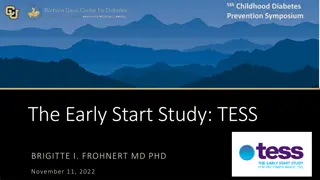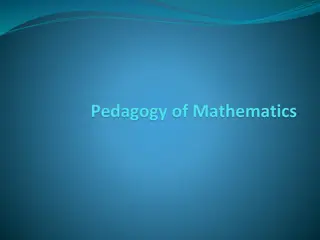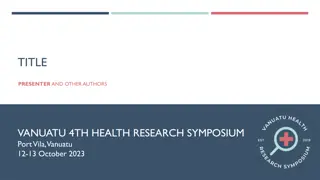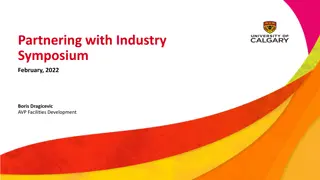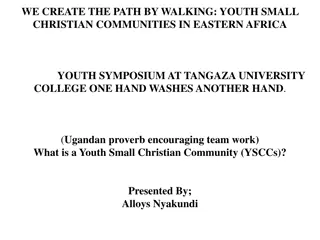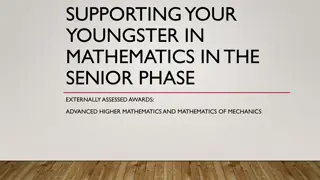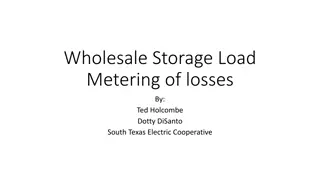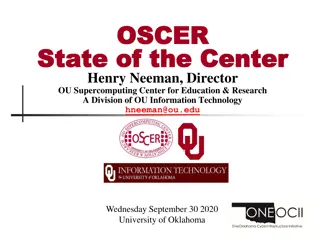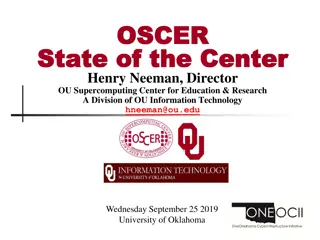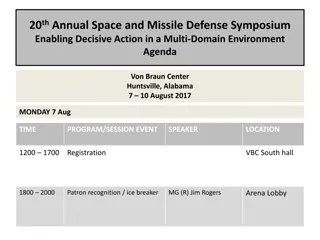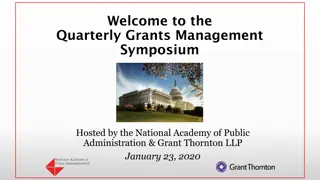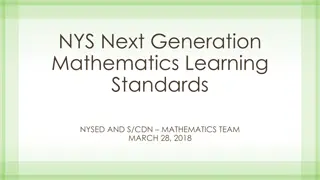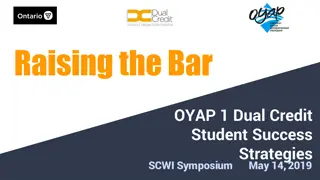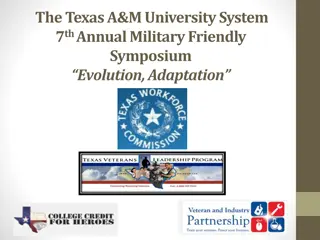Transforming Mathematics Education for a New Generation Symposium Insights
This symposium explores the evolution of curriculum standards in science and mathematics over the years, highlighting key milestones such as the NCTM standards, Ohio Model, Common Core State Standards, and the Principles to Actions initiative. It emphasizes the importance of adopting college- and career-readiness standards to enhance mathematical education nationwide.
Download Presentation

Please find below an Image/Link to download the presentation.
The content on the website is provided AS IS for your information and personal use only. It may not be sold, licensed, or shared on other websites without obtaining consent from the author.If you encounter any issues during the download, it is possible that the publisher has removed the file from their server.
You are allowed to download the files provided on this website for personal or commercial use, subject to the condition that they are used lawfully. All files are the property of their respective owners.
The content on the website is provided AS IS for your information and personal use only. It may not be sold, licensed, or shared on other websites without obtaining consent from the author.
E N D
Presentation Transcript
Science and Mathematics for a New Generation NWO Symposium Daniel J. Brahier Bowling Green State University St. Rose School, Perrysburg Saturday, November 21, 2015 8:30 9:45 a.m., 101 Olscamp Hall, BGSU
Boston Globe Article Did you see this Opinion piece in the Boston Globe from February 12, 2015?
Best Jobs (CareerCast, 2014) 1. Mathematician 2. Tenured University Professor 3. Statistician 4. Actuary 5. Audiologist 6. Dental Hygenist 7. Software Engineer 8. Computer Systems Analyst
Best Jobs (CareerCast, 2014) 1. Mathematician 2. Tenured University Professor 3. Statistician 4. Actuary 5. Audiologist 6. Dental Hygenist 7. Software Engineer 8. Computer Systems Analyst
Some History 1989 NCTM Curriculum Standards 1991 Ohio Model (8 Strands) 2000 NCTM Principles and Standards 2002 Ohio Academic Content Standards 2010 Common Core State Standards 2011 Ohio Model Curriculum
Principles to Actions: Ensuring Mathematical Success for All 9
Principles to Actions: Ensuring Mathematical Success for All Now, twenty-five years later, the widespread adoption of college- and career-readiness standards, including adoption in the United States of the Common Core State Standards for Mathematics (CCSSM) by forty-five of the fifty states, provides an opportunity to reenergize and focus our commitment to significant improvement in mathematics education. 10
Batting Averages Batting Average = ratio of hits to times at bat (e.g., 3 hits for 10 at bats is a 0.300 Average) 0.132 Hits a Single! 0.154
How many hits does the player have, and how many times has he been at bat so far this season? Can you think of at least two different ways to come up with a solution? 0.132 0.154
Simultaneous Equations y+1 x+1= .154 y x= .132
Premise/Assumption Technology is an inescapable fact of life in the world in which we live and should be embraced as a powerful tool for doing mathematics. Use of technology can assist students in visualizing and understanding important mathematical concepts and support students mathematical reasoning and problem solving. -Principles to Actions, page 83
Methods Student - Technology Since the students were unable to download the Puffin Application to their iPads, the technology specialist gave the class a laptop cart to use. This is where we hit another problem. The laptops they used had to be logged into with a password. Luckily, one of the students discovered that the password was pchs . Once logged on, it was discovered that the students did not have internet access. As a class, we went through some different strategies and successfully got the internet to work. After that, students went to an internet browser where it said that the latest Adobe Flash Player had to be installed. So, each student downloaded the latest version and then proceeded to the website that had the virtual manipulatives. When we finally got to the website, the lesson officially began.
Investigation Let s examine some data to see if we can predict when Old Faithful Geyser will erupt.
Process Each table randomly chooses 2 days. Each person asks, What do I notice? What do I wonder about? Each person creates some kind of display of the data by hand. Team compares displays, chooses favorite, and predicts wait time. Each team presents solution.
Discussion Questions Would you want Samantha or Eric to present her/his solution first to the class? Why? Is it necessary or even important for both of them to present their solutions?
Common Ground in Mathematics and Science Mathematical/Scientific Practices Modeling Use of Variables (Algebra)
Standards for Mathematical Practice 1. Make sense of problems and persevere in solving them. 2. Reason abstractly and quantitatively. 3. Construct viable arguments and critique the reasoning of others. 4. Model with mathematics. 5. Use appropriate tools strategically. 6. Attend to precision. 7. Look for and make use of structure. 8. Look for and express regularity in repeated reasoning.
Practices for Science and Engineering 1. Asking questions and defining problems 2. Developing and using models 3. Planning and carrying out investigations 4. Analyzing and interpreting data 5. Using mathematics and computational thinking 6. Constructing explanations and designing solutions 7. Engage in argument from evidence 8. Obtaining, evaluation, and communicating information
Practices for Science and Engineering 1. Asking questions and defining problems 2. Developing and using models 3. Planning and carrying out investigations 4. Analyzing and interpreting data 5. Using mathematics and computational thinking 6. Constructing explanations and designing solutions 7. Engage in argument from evidence 8. Obtaining, evaluation, and communicating information
Action Research Two high school teachers asked Precalculus students to complete the phrase, I like math most when
I like math best when... 35 32 30 25 19 20 14 14 15 10 10 10 4 5 3 0 I can learn it myself I am given steps to follow I can have many practice problems I can pursue my own questions I can collaborate with my peers I can use problem solving I can memorize how to do it Other
Discussion How do you explain the results of this survey?
Modeling 1. Identifying the key variables in the problem 2. Creating models (algebraic, geometric, etc.) using the variables 3. Analyzing the relationships and performing operations to draw conclusions 4. Interpreting the results 5. Validating the conclusions, with the possibility of modifying the model Common Core State Standards for Mathematics, 2010
Uses of Variables #1 Represent a number in a generalized pattern Example: a + b = b + a
Uses of Variables #2 Represent a fixed but unknown number Example: The letter x in the equation 2x 3 = 7
Uses of Variables #3 Represent a quantity that varies, especially in relation to another quantity Example: The letters x and y in 3y = x
Uses of Variables #4 Represent a parameter (i.e., a quantity whose value determines the characteristics of another variable) Example: The letter m in y = mx or in E = mc2
Application of Formulas Consider F = ma
Uses of Variables #5 Represent an arbitrary or abstract place holder in an algebraic process Example: The letter t in the statement, Factor the trinomial: t2 + 3t - 10
Myth About Being Bad at Math Consider this article published in September 2015
Thought Advice to teachers: Avoid saying, You re so smart and, instead, acknowledge the work they did to accomplish something (e.g., I can only imagine how long you spent studying for this test ).
A Gift? It s hard to watch, and it s even harder to not jump in when we see our kids frustrated or upset [but] learning that comes with challenge is stored more effectively and more durably in the brain than learning that comes easily errors are an integral part of learning (2015, pp. 39-41)
Lessons Learned in Singapore Just because our students were #1 in the world last year doesn t mean they will be next year. If our students aren t scoring 100%, then we can do better we can always improve.


